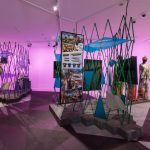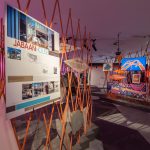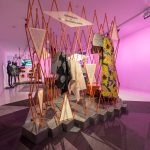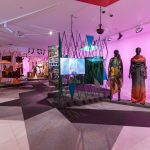
A survey of contemporary Indigenous design
Blak Design Matters
Overview
Blak Design Matters was the first national survey of contemporary Indigenous design curated by Jefa Greenaway at the Koorie Heritage Trust. From fashion, interiors, and product design to landscape, architecture and town planning, the exhibited projects interrogate how Indigenous design is defined, received, and made visible in Australia’s contemporary design landscape, asking the question, what is Indigenous design, and why does it matter?
Jefa Greenaway worked in collaboration with Sibling Architecture to create the exhibition design. Place is central to the exhibition design with plinths made of basalt, or bluestone, that formed hundreds of millions of years ago across the region after lava flows. Atop the stone, a universal display system was created to accommodate the varying works, such as garments, publications, jewellery and videos. Prefabricated steel diamond mesh – with bold colours selected from Marcus Lee Designs’ identity for the show – create variation across the space. With the walls devoid of work, light omits purple and pink-ish hues to create shadows and patterns.

The exhibited projects interrogate how Indigenous design is defined, received, and made visible in Australia’s contemporary design landscape, asking the question, what is Indigenous design, and why does it matter?

With the walls devoid of work, light omits purple and pink-ish hues to create shadows and patterns.

Place is central to the exhibition design with plinths made of basalt, or bluestone, that formed hundreds of millions of years ago across the region after lava flows.


The exhibited projects interrogate how Indigenous design is defined, received, and made visible in Australia’s contemporary design landscape, asking the question, what is Indigenous design, and why does it matter?

With the walls devoid of work, light omits purple and pink-ish hues to create shadows and patterns.

Place is central to the exhibition design with plinths made of basalt, or bluestone, that formed hundreds of millions of years ago across the region after lava flows.




